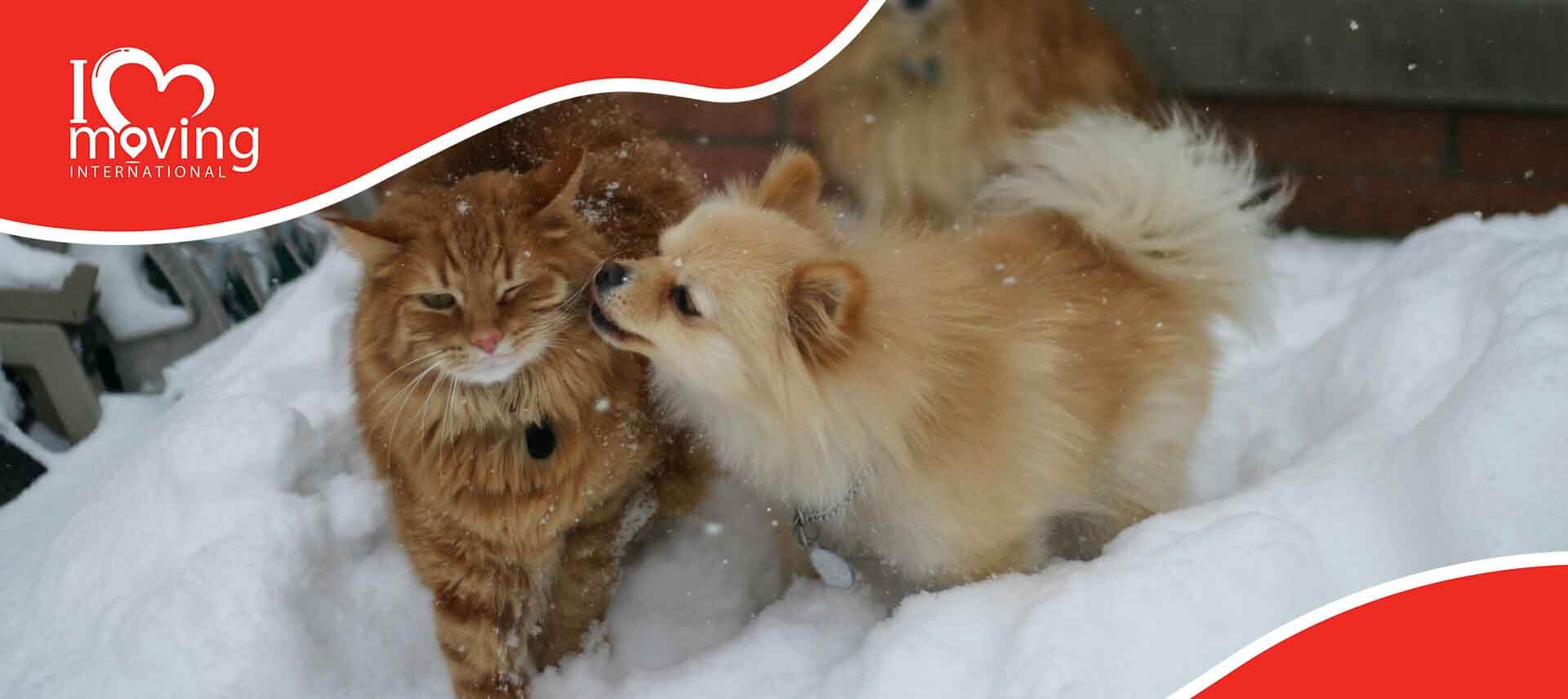Have you been thinking about relocating to the Great White North with your animal companion? If so, there are some rules and regulations you should be familiar with when moving to Canada with pets. Even if you’ve already moved with your animal friend someplace else, you should check these rules to see what might be different. Each destination is specific, so let’s find out what it takes to relocate to Canada with a pet.

Every move is rather challenging, but when you add animals to the equation, things become a bit more complicated. However, there’s no need to panic. No matter how daunting it all might seem at first, everything is manageable with the right instructions. You should just take it one step at a time and know your priorities. To help you handle this properly, we have prepared this guide on how to relocate with your furry friend. Let’s find out more about the crucial steps to take.
Make Sure Your Pet Breed Is Not Banned
Before you can get down to some further preparations for moving with pets overseas, you should be sure you are allowed to bring your companion. Depending on the part of the country you’re relocating to, the rules regarding certain breeds may differ. So, you should read more about banned breeds in your chosen province. For instance, if you’re moving to Winnipeg or Ontario, you won’t be allowed to bring the following dog breeds:
- American Pit Bull Terrier
- American Staffordshire Terrier
- Staffordshire Terrier
- Pit Bull Terrier
As for other types of pets, you are allowed to bring rabbits, gerbils, fish, hamsters, birds, and many other species. It would be best to find more info regarding your pet’s species and breed, in particular, to be on the safe side. The import of live animals to Canada is overseen by the Canadian Food Inspection Agency (CFIA), so the most reliable solution is to check out their rules regarding your pet’s specific breed. Once you make sure your buddy will be welcome, it’s time to get ready for the move, starting with visiting a certified vet.

Check Whether Your Pet Is Healthy Enough to Travel and Get a Health Certificate
People move with all kinds of animals, from dogs and cats to rabbits and birds. Be it a dog or a parrot, one of the most significant rules applies – you can’t enter Canada with your pet without a health certificate. The health certificate must be in English or French. It is also required that the certificate bears the signature of a USDA (United States Department of Agriculture) accredited veterinarian. Apart from this, make sure the health certificate states the following information:
- The pet‘s breed, color, and weight
- The trade name and serial number of the vaccine
- A statement that the animal has been vaccinated and immunity duration
Not only do you need this certificate to fit Canadian requirements, but it is also crucial to make sure that your faithful companion is healthy enough to travel. If you’re going by plane, remember that this can be a stressful experience for your precious companion. So, take your dog, cat, bird, or whatever pet you have to the vet to be sure it can endure such stress and all those changes that come with relocation.

Implant an ISO Microchip
Unlike many other countries, Canada does not require microchips for entry into the country. However, even though this is not a specific requirement, it is still highly recommended that your pet does get a microchip implanted. Namely, a 15-digit ISO-compliant microchip is often recommended if you want to be on the safe side. In case you and your buddy are separated during the trip, or it gets lost upon arrival, things can get complicated without any contact information.
When you ensure microchip implantation, however, it will serve as a means of identification. Adjusting to a new country after moving can be rather challenging for people and animals alike. So, be sure your companion is safe in case it gets lost in the new city during the first days upon your arrival. Naturally, no one likes thinking about such scenarios, but remember that this microchip is recommended for a reason.
We should also note that there is one particular situation when the microchip will be not only recommended but necessary – under the commercial category. This applies if you’re traveling with a dog under eight months for breeding purposes, show, or one destined for adoption.

Dogs and Cats Might Get Hungry During the Trip, So Pack Enough Food
When moving across the world, you can expect your companion to get hungry at some point during your trip. Thus, you should be prepared and keep enough snacks and water close to be sure your companion is comfortable during the entire journey.
When it comes to these regulations, you should know that everything should be in a sealed bag, manufactured in the United States, and commercially packaged. In addition to this, keep in mind that you’re allowed to bring up to 44 pounds of food. Both your companion and the food should be with you at the POE (Port of Entry). Finally, you can use the food you bring to feed only the animal that accompanies you on the trip. Be sure you follow these rules so that your companion is not left without snacks and refreshments during the long journey.

Most Important Things to Bring When Moving to Canada With Pets
Since you are getting ready for an international move, careful planning and organization are of paramount importance. One simple mistake can lead to a significant problem, and we’re sure you don’t want that to happen. Thus, don’t skip any crucial steps that could affect your dear friend. It is advisable to make a checklist of the most important things to do to avoid forgetting something. Among other points, that checklist should include all documents containing relevant information about your companion.
Let’s see what you should put in your bag first when traveling with animals, regardless of the pet’s breed, size, color, or age.

Remember That You Can’t Enter Canada With Your Pet Without the Needed Travel Documents
Before you leave your home, you will double-check if you’ve packed the most important documents needed to travel abroad. You should do the same for your companion, too. When you start wondering what to pack, let this be at the top of your list. It is crucial to understand Canadian import and travel requirements to know which documents you can’t do without to ensure a smooth move. So, pack the required documents first, and then you can move on with packing your stuff.
Speaking of packing, keep in mind that you can always contact experts who offer packing services to save you the trouble. In addition to the actual wrapping, they can also provide you with the needed boxes and moving supplies. It is convenient to have someone else take care of these tasks so that you have enough time to focus on how to organize the relocation with animals.
In case your pet is traveling as an unaccompanied cargo, you will be required to provide a copy of your passport, work permit or visa, and signed customs clearance.
Don’t Forget to Bring Proof of Rabies Vaccination and Other Medical Information
As previously mentioned, you will need to get a health certificate to be able to enter the country. The most significant piece of information regarding your pet’s health is proof of rabies vaccination. When you have this proof, you can forget about quarantine, which is excellent news both for your companion and yourself. Otherwise, the quarantine will be required.
Several other vaccines will be required. For instance, if you’re moving with dogs, Canine Distemper, Parvovirus, Hepatitis, and Leptospirosis vaccination will be required. Those moving with cats should know that the most common vaccination requirements include Feline Cat Flu-Feline Calicivirus, Feline Viral Rhinotracheitis, and Chlamydia Psittacosis.
Those relocating from rabies-free countries are the only ones allowed to bring their animals without proof of vaccination. Among other countries, these include the United Kingdom, Norway, Sweden, Finland, New Zealand, Australia, Barbados, Bahamas, etc. But if you’re relocating from the United States and you want to avoid quarantine, be sure you have the proof of vaccination.
If You’re Traveling with Exotic Pets, Keep Import Permit Close
Things are not that intricate when you’re traveling with dogs or cats. But what about exotic species? In case you’re relocating with an exotic animal, there will be some specific requirements. You will be required to obtain an entry permit to have proof that you’re allowed to travel with that exotic species. Otherwise, the entry shall be considered illegal.
Some of the most common exotic animals include parrots, turtles, lizards, and snakes, as well as hybrid cats. You can contact the Convention on International Trade in Endangered Species of Wild Fauna and Flora (CITES) to provide more information on exotic species. If you’re not sure whether your animal classifies as one, be sure to check their list and see whether your companion belongs there. If so, you will be required to provide an import permit, so don’t forget to pack it with the rest of the most important documents.
Even though traveling with an exotic animal might require a bit more preparation, you’ll be happy to hear that Canada isn’t the strictest place around. Many exotic species are welcome here. You should just prepare for the trip adequately and meet all requirements.

Summary
No matter how complex international relocation with pets might be, there is no doubt that all pet owners would agree that it’s worth the trouble. You can’t imagine your new life without your furry, feathery, or scaly friend around. Thus, you’ll do anything necessary to bring your companion with you.
If you’re moving to Canada, follow the previously mentioned steps and tips, and you’re good to go. Contact expert movers to handle the actual relocation process, from packing to overseas vehicle shipping, and take the time you need to make it all run smoothly. Search for every requirement specific to your pet’s species and breed to avoid any unpleasant surprises along the way. Head straight to your vet (or find an accredited one if your current vet is not licensed) and gather all the necessary medical documentation. Pack your pet’s favorite toys and snacks for the trip and begin the lovely journey to your new home.








